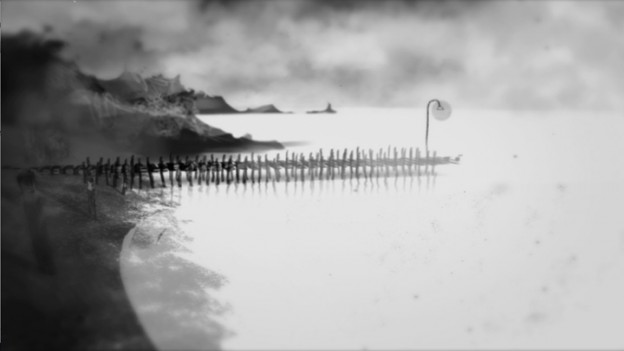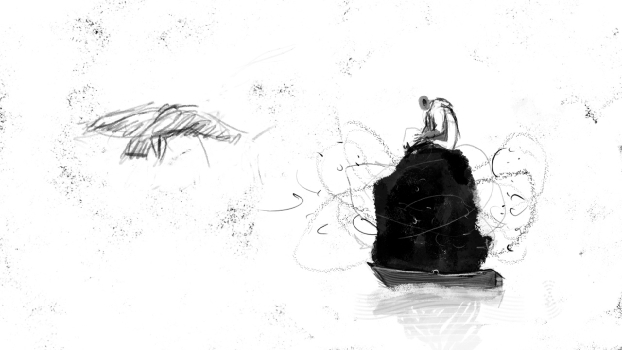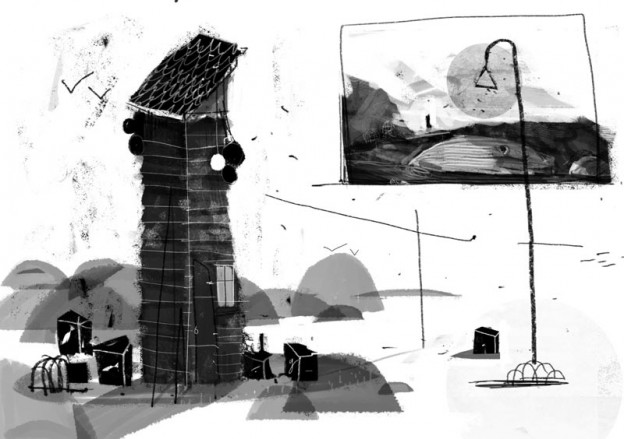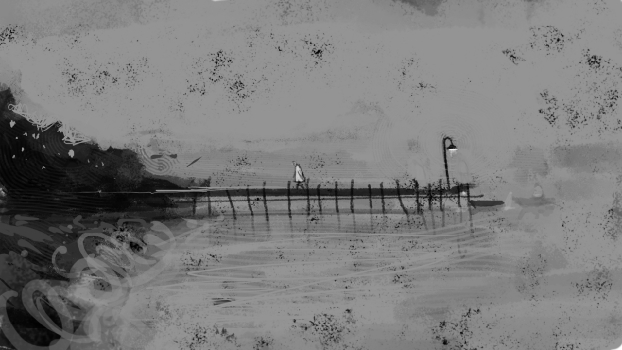Interview: Dave Prosser Talks His New Film ‘Matter Fisher’
Upon first watching Matter Fisher I am reminded of classic poems like The Rime of the Ancient Mariner. The kind of tale that elderly fishermen tell passers-by in port taverns, folklore that attempts to explain the disappearance of a local seafaring merchant ‘some years back’. Unlike the Ancient Mariner’s Rime though, Matter Fisher is devoid of words, a script or even a clear conclusion. You are forced to come up with your own tale to pass on, a Chinese whisper of interpretations over what happened to the nameless fisherman on that strange morning. For that reason I won’t indulge you with my view, instead relying on you to watch it for yourself (video at the bottom of the page). You won’t be disappointed.
The visual style of the animation is incredible, combining multiple techniques and effects encouraging you to peel back the various layers to explore how it was made. A purely black and white palette is often used in animation but rarely executed with this kind of quality, which lends itself to many beautiful textures. Another point that I can’t stress enough is the amazing sounds used in the piece. The work of sound designer Joe Tate brings an amazing level of depth to the often minimalist visuals. Never before have I felt that the sound effects of an animation were as paramount to a piece as they were to Matter Fisher. Truly this was a marriage between audio and visuals made in Heaven.

David Prosser’s 2010 graduation masterpiece has toured around the world in numerous festivals and screenings and it is easy to see why he is represented as a director and designer by one of the most influential British animation companies: Studio AKA. It’s impossible not to be taken back by the amazing body of work that they produce and it can only get better now that David Prosser is involved.

David Prosser
You have a very distinctive art style. Who were your biggest influences and inspirations in shaping your style?
I was raised on family holidays spent in a quaint seaside town named St Ives in Cornwall and the dramatic Cornish landscape has always been a huge inspiration. I guess Matter Fisher is my homage to this.
A resident of St Ives, Alfred Wallis, was an outsider artist at this time and opened the door of naïve/folk art to me in my youth and immediately I began to appreciate instinctive quirks within drawing and painting which translated into my work. Like many a child, I was nurtured on vast amounts of Roald Dahl tales and as a result of this Quentin Blake became an influence which echoed through my youth into my adulthood.
I stumbled across a fantastic German Illustrator called Martin Tom Dieck and was lured into his world of illustrated storybooks, particularly a story named Hundert Ansichten der Speicherstadt, in which tells a strange story of a town flooding. Lately animators, such as Igor Kovalyov, are a huge inspiration to me and to many others I expect.
There is a phenomenal amount of textured layers and effects on each shot. How much of these were experiments and how much were pre-planned?
There’s actually probably not as many as you think. I used a variety of home-brewed Photoshop brushes to create the various layers of texture. The process of creating these textures was very fluid and organic, so was the process of applying them in a relatively haphazard unstructured manner. I originally studied illustration as an undergraduate and as a result of this process based work, making mistakes was a necessary ingredient for my work. I feel that anything that is over planned/overworked loses a particular emotional attachment that I respond to and I try to retain this in my work via spontaneity.

The sound feels very important to the design of the animation. How early was Joe Tate involved or was it completed before he received it?
Joe and I were good friends before embarking upon a creative partnership together. We lived together throughout the process of making MF so he was there for the initial spark for the film, and actually contributed to some of the writing. As we lived together he therefore saw the process of the animation on a day-by-day basis, a rarity in animation but I believe in an ideal world this is how I would always like my collaborations to work.
Even though the lead has no script he still comes across very likable as a character. How many designs did you go through to get to him?
I don’t necessarily believe that a lead character, or any character whatsoever, has to have a script for them to resonate with an audience. I feel that people can often respond more emotionally to physical characteristics of a character rather than the dialogue. He’s a curious fellow, very much the pacifist who is drawn by peculiar forces.

A lot of directors choose to not use storyboards. How important do you feel they are? Should story-boarders receive more credit?
I think storyboards are imperative to the cognitive process. I don’t really know of many directors that don’t use storyboards and I would only storyboard my own work rather than hire someone to do this. How rigidly you stick to this guide throughout is a different matter. Personally, I allow for some flexibility when boarding. I feel that story board artists should receive maximum props.
What’s your opinion on the British Animation industry as a whole? The government cuts on the Arts? The BBC’s dedication to originality?
As graduating directors/animators we are entering a world completely alien to even five years ago in the industry. It deeply saddens me to see schemes such as Animate Projects die a death with nothing to follow in its wake, and with the closure of the UK film council it would seem the foreseeable future looks bleak for funding for filmmakers. It would seem that this is why many students are reaching out over the Internet by uploading and showcasing their films online in hope of attracting as much attention from all over the world and in hope of finding work or funding. I’m relatively new to the animation industry as I graduated last year and was lucky enough to find full-time work at Studio AKA straight away. From my brief time there I would still say commercially it is in relatively good shape. In London the animation crowd seems like a tightly knit community with most directors knowing each other personally, I feel this helps breed healthy competition between friends and associates. That said it is by no means an exclusive group. There also seems to be a large proportion of young skilled French animators filling up the studios from schools such as Supinfocom and Gobleins. They are fuelling the 3D hungry world of advertising. And of course there are still those young directors with weighty egos…
![sb_05 []](https://www.skwigly.co.uk/wp-content/uploads/2011/05/sb_05-.jpg)
Your style is very ‘in vogue’ with the graphic design industry. Do you think the line between creative art and functional design is blurring?
Again, I would probably protest over the idea that my style is ‘in vogue’. My voice has formed from my formative years as an illustrator and lots of time spent drawing, observing and throwing ideas away. Stylistically I feel that my work is grounded in solid draftsman skills which will hopefully let my voice transform over time. The look of Matter Fisher was not a conscious choice, it is simply an extension of my previous films and work. I feel more inclined to say that the design industry has taken more interest in this type of ‘look’, rather than the opposite way around.
Are you tempted to take the fisherman to the next level? Will we be seeing vinyl toys since the options are now so readily available?
I’m personally not interested in gimmicky merchandise, besides no one aside from my mum would buy it. Although if approached I would love to commission a 40ft amorphous matter ball made from gloss black wipe clean latex.

What’s the most influential animation you watched? What made you want to be an animator?
Recently, I believe the most inspirational film I’ve seen is Rains by David Coquard-Dassault from the NFB. The film is effortlessly tasteful and retains a sophistication that is so easy to loose in animation. It feels classical and magical and stays away from the ironic, gaudy design that seems to be increasingly popular in pockets of London.
I never really wanted to become an animator; I’d much prefer to be an illustrator.
Studio AKA seems to have a distinctive split with their entertainment projects and their commercial projects. What is the rough ratio and how important is the ‘narrative’ projects (stuck on a Sunday) to their business model?
It is important for any company to keep developing their own projects alongside commercial work. I think Studio AKA have a healthy balance to keep it from stagnating. If any company could avoid doing commercial work I’m sure they would.

The Illusionist, A Waltz with Bashir, Persepolis… are we going to be seeing any feature length British animations any time soon?
I’m positive we will, very soon…
BAFTA Nominated Short 2011
Synopsis: An excerpt from my RCA graduation film. A serendipitous journey in which a lone fisher is united with a form of estranged matter.
Director: David Prosser
Sound Design: Joe Tate
Assistant Animation: Eamonn O Neill, Gergely Wootsch
Mixed By: Nikola Zivojinovic
Mixed at: National Film and Television School
Production: Royal College of Art, 2010©
Interview by Ilan Sheady
Ilan Sheady is an illustrator, animator and cartoonist wrapped up together in the body of one very large, hairy teddy bear. (His own words)

